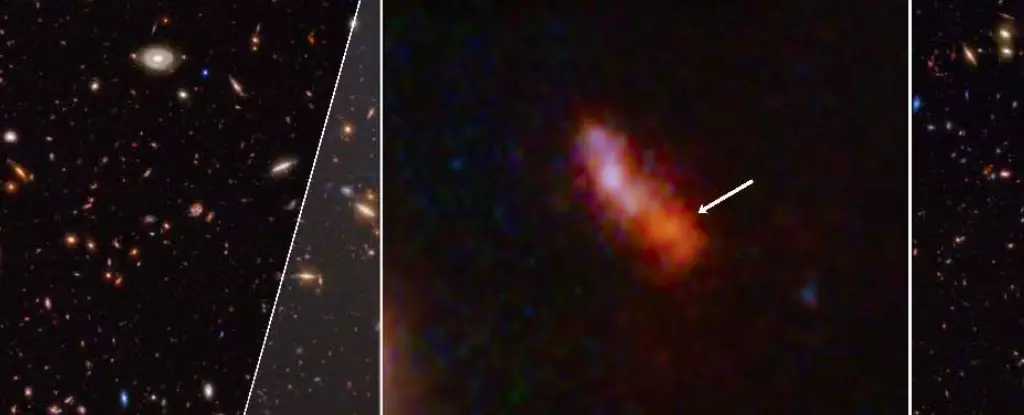The James Webb Space Telescope (JWST) is redefining our understanding of the cosmos, standing at the forefront of astronomical discovery. With its unprecedented capability to observe the faint glow of galaxies originating from just 280 million years after the Big Bang, the JWST brings us tantalizingly closer to answering fundamental questions about the universe’s early days. One of its most remarkable discoveries is a newly identified galaxy, MoM-z14, which has emerged from the depths of the cosmos, showcasing the powerful potential of this revolutionary telescope.
Previously, our ability to probe the early universe was hindered by the limitations of earlier infrared telescopes. The Hubble Space Telescope made significant contributions with its 2.4-meter mirror; however, its reach was limited. The Spitzer Space Telescope, an infrared specialist, operated with an 85 cm mirror, leaving us with only glimpses of galaxies from the universe’s infancy. Enter the JWST, equipped with a mirror spanning 6.5 meters, allowing astronomers to capture light from far-flung galaxies obscured by time and distance.
MoM-z14: A Cosmic Marvel
MoM-z14, the galaxy at the heart of this discussion, emerges as a beacon of light from a time previously thought to contain few stars. In a groundbreaking paper led by Rohan Naidu from the MIT Kavli Institute for Astrophysics and Space Research, the findings reveal that the JWST has uncovered an unexpected multitude of bright galaxies, particularly at redshifts above z=10. The galaxy MoM-z14, with its astounding redshift of 14.4, pushes the observational boundary back to mere moments after the Big Bang, represented by the impressive figure of 280 million years.
The very existence of such luminous galaxies at this early stage in cosmic history challenges pre-existing theories about galaxy formation. The authors of the associated study acknowledge that the astonishing array of bright galaxies discovered by the JWST has invigorated the scientific community, raising important questions about how these celestial bodies came to be. The findings are not just curiosities; they offer insightful connections to the ongoing research on galaxy assembly and evolution, a primary focus of JWST’s scientific mission.
Illuminating Early Stellar Chemistry
Further examining MoM-z14, researchers found intriguing chemical signatures suggesting that its light emanates primarily from active stars rather than a supermassive black hole at its center—a distinct departure from what is often observed in similar galaxies. This discovery provides critical insights into the conditions that prevailed when the universe was young. Interestingly, the nitrogen-to-carbon ratio observed in MoM-z14 surpasses that found in our own Sun, indicating a composition akin to the ancient globular clusters orbiting the Milky Way.
The chemical environment within MoM-z14 implies that the stars forming within it likely experienced conditions comparable to the earliest stars in our galaxy. Such findings suggest a stronger link between the formation environments of ancient stars and contemporary galaxies than previously recognized. This intriguing overlap points to a potential thread of continuity in the evolutionary pathways of the cosmos, linking the distant past with our present understanding of galactic development.
Diverse Morphologies and Evolving Theories
One striking observation made through JWST’s observations is the emergence of two morphological types of ancient galaxies; these include both compact sources and extended elements. This novel classification provides further context for understanding the diversity within the cosmic tapestry. Research indicates that these morphological differences may encompass deeper connections to their respective chemical abundance patterns, providing a nuanced framework in which to assess galaxy formation theories.
As more powerful telescopes like the JWST unearth hidden wonders of the distant universe, new classes of celestial entities are coming to light. Among these are the luminous “Little Red Dots,” a category that includes MoM-z14 and showcases intriguing spectral characteristics. These nitrogen-enhanced galaxies may hold the key to understanding the interplay between stellar evolution and chemical composition at such early epochs.
The Future of Cosmic Exploration
As the JWST continues to reveal the hidden secrets of the universe, it instills a sense of anticipation within the scientific community. The breadth of discoveries, including the intricate relationships between morphology, chemistry, and star formation, invites fresh questions and hypotheses. Culling insights from these ancient celestial bodies allows researchers to weave a narrative linking the universe’s formative epochs to the structures we observe today.
The potential for the American-led Roman Space Telescope to expand on these early findings represents another hopeful chapter in the ongoing quest to understand our universe. As JWST paves the way through previously insurmountable barriers, it emerges not only as a tool for observation but as a catalyst for scientific inquiry that challenges our understanding of the cosmos at its most fundamental level. The tapestry of the universe is rich with stories yet to be told, and the tools of modern astronomy are finally revealing their complexity.


Leave a Reply